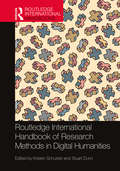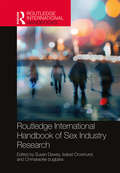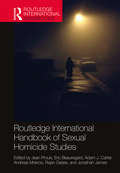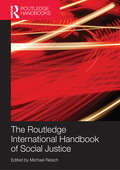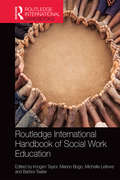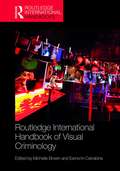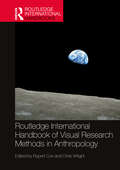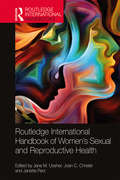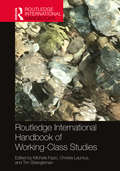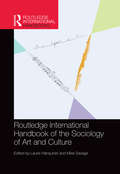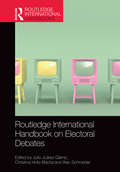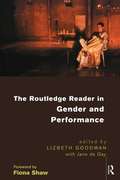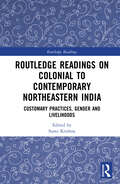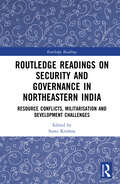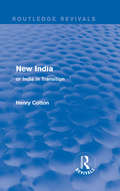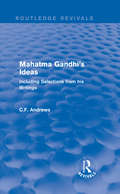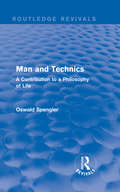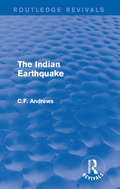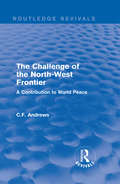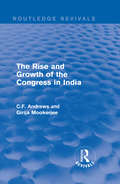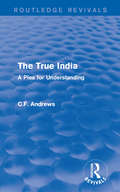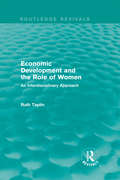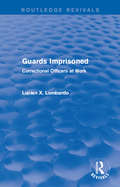- Table View
- List View
Routledge International Handbook of Research Methods in Digital Humanities
by Stuart Dunn Kristen SchusterThis book draws on both traditional and emerging fields of study to consider consider what a grounded definition of quantitative and qualitative research in the Digital Humanities (DH) might mean; which areas DH can fruitfully draw on in order to foster and develop that understanding; where we can see those methods applied; and what the future directions of research methods in Digital Humanities might look like. Schuster and Dunn map a wide-ranging DH research methodology by drawing on both ‘traditional’ fields of DH study such as text, historical sources, museums and manuscripts, and innovative areas in research production, such as knowledge and technology, digital culture and society and history of network technologies. Featuring global contributions from scholars in the United Kingdom, the United States, Europe and Australia, this book draws together a range of disciplinary perspectives to explore the exciting developments offered by this fast-evolving field. Routledge International Handbook of Research Methods in Digital Humanities is essential reading for anyone who teaches, researches or studies Digital Humanities or related subjects.
Routledge International Handbook of Rural Studies (Routledge International Handbooks)
by Mark Shucksmith and David L. BrownRural societies around the world are changing in fundamental ways, both at their own initiative and in response to external forces. The Routledge International Handbook of Rural Studies examines the organisation and transformation of rural society in more developed regions of the world, taking an interdisciplinary and problem-focused approach. Written by leading social scientists from many countries, it addresses emerging issues and challenges in innovative and provocative ways to inform future policy. This volume is organised around eight emerging social, economic and environmental challenges: Demographic change. Economic transformations. Food systems and land. Environment and resources. Changing configurations of gender and rural society. Social and economic equality. Social dynamics and institutional capacity. Power and governance. Cross-cutting these challenges are the growing interdependence of rural and urban; the rise in inequality within and between places; the impact of fiscal crisis on rural societies; neoliberalism, power and agency; and rural areas as potential sites of resistance. The Routledge International Handbook of Rural Studies is required reading for anyone concerned with the future of rural areas.
Routledge International Handbook of Sex Industry Research (Routledge International Handbooks)
by Susan Dewey Isabel Crowhurst Chimaraoke IzugbaraThe Routledge International Handbook of Sex Industry Research unites 45 contributions from researchers, sex workers, activists, and practitioners who live and work in 28 countries throughout the world. Focusing tightly on the contemporary state of sex industry research through eight carefully selected themes, this volume sets a clear agenda for future research, activism, and policymaking. Approaching the topic from a multidisciplinary perspective on an expanding field frequently divided by political and ideological conflicts, the handbook clearly establishes the parameters of the field while also showcasing the most vibrant contemporary empirical and theoretical work. Unprecedented in its global scope, the Routledge International Handbook of Sex Industry Research will appeal to students, researchers, and policy makers interested in fields such as sociology of gender and sexuality; crime, justice, and the sex industry; sociology of work and professions; and sexual politics.
Routledge International Handbook of Sexual Homicide Studies (Routledge International Handbooks)
by Jean Proulx Eric Beauregard Adam J. Carter Andreas Mokros Rajan Darjee Jonathan JamesThis book provides the first systematic overview of the theoretical, empirical, clinical, and police issues related to sexual murderers and murder. Bringing together leading researchers, theoreticians, and practitioners from across eight different countries, this is a truly international collaboration and an essential reference text for students, researchers, and professionals interested in sexual homicide, as well as an exhaustive source of guidelines for the assessment and treatment of sexual murderers. This book is divided into five parts: Part I, Theories and research, presents a detailed review of theoretical models and empirical studies of sexual homicide. Part II, Sexual sadism, discusses theoretical, empirical, and clinical considerations and reviews the literature on the characteristics of sadistic sexual aggressors. Part III, Clinical issues, discusses the assessment and management of sexual murderers at each phase of the judicial process: at trial, during incarceration, and during follow-up in the community. Part IV, Policing issues, discusses research and practical issues related to police activities surrounding a sexual murder. Topics include investigation, offender and geographical profiling, behavioural linkage, and police interrogation of the murderers. Part V, New directions, presents new directions for the study of sexual homicide and discusses the limits of current knowledge related to sexual murderers and their crimes. Offering a broad and comprehensive approach, this Handbook is an indispensable source of information on theory, research, clinical assessment, treatment, and police issues related to sexual murderers and murder.
Routledge International Handbook of Social Justice
by Michael ReischIn a world where genocide, hunger, poverty, war, and disease persist and where richer nations often fail to act to address these problems or act too late, a prerequisite to achieving even modest social justice goals is to clarify the meaning of competing discourses on the concept. Throughout history, calls for social justice have been used to rationalize the status quo, promote modest reforms, and justify revolutionary, even violent action. Ironically, as the prominence of the concept has risen, the meaning of social justice has become increasingly obscured. This authoritative volume explores different perspectives on social justice and what its attainment would involve. It addresses key issues, such as resolving fundamental questions about human nature and social relationships; the distribution of resources, power, status, rights, access, and opportunities; and the means by which decisions regarding this distribution are made. Illustrating the complexity of the topic, it presents a range of international, historical, and theoretical perspectives, and discusses the dilemmas inherent in implementing social justice concepts in policy and practice. Covering more than abstract definitions of social justice, it also includes multiple examples of how social justice might be achieved at the interpersonal, organizational, community, and societal levels. With contributions from leading scholars around the globe, Reisch has put together a magisterial and multi-faceted overview of social justice. It is an essential reference work for all scholars with an interest in social justice from a wide range of disciplines, including social work, public policy, public health, law, criminology, sociology, and education.
Routledge International Handbook of Social Work Education (Routledge International Handbooks)
by Marion Bogo Imogen Taylor Barbra Teater Michelle LefevreThe Routledge International Handbook of Social Work Education provides an authoritative overview of current understanding through coverage of key debates, exploring the state of play in particular social work education fields and reflecting on where the future might be taking us. The overall aim of the Handbook is to further develop pedagogic research and scholarship for social work education. Drawing on medical education as an exemplar, the contributions view social work education as a specialism and a field of expertise that counts in the same way as research programmes in more traditional areas of social work practice. The chapters are concerned with the theory and practice of social work education at all levels; they are accessible, conceptually clear, research based where appropriate, critically reflective and ethically underpinned. The Handbook is organised into seven sections that reflect the proposed themes and sub-themes covering: Social work education in context: the western drivers Emerging and re-emerging social work education The scholarship of learning and teaching New insights into field education New directions in learning and teaching Future challenges in social work education This handbook presents a contribution to the process of exchange and dialogue which is essential to global social work education. It brings together professional knowledge and lived experience, both universal and local, and will be an essential reference for social work educators, researchers, students and professionals.
Routledge International Handbook of Visual Criminology
by Michelle Brown Eamonn CarrabineDynamically written and richly illustrated, the Routledge International Handbook of Visual Criminology offers the first foundational primer on visual criminology. Spanning a variety of media and visual modes, this volume assembles established researchers whose work is essential to understanding the role of the visual in criminology and emergent thinkers whose work is taking visual criminology in new directions. This book is divided into five parts that each highlight a key aspect of visual criminology, exploring the diversity of methods, techniques and theoretical approaches currently shaping the field: • Part I introduces formative positions in the developments of visual criminology and explores the different disciplines that have contributed to analysing images. • Part II explores visual representations of crime across film, graphic art, documentary, police photography, press coverage and graffiti and urban aesthetics. • Part III discusses the relationship of visual criminology to criminal justice institutions like policing, punishment and law. • Part IV focuses on the distinctive ethical problems posed by the image, reflecting on the historical development, theoretical disputes and methodological issues involved. • Part V identifies new frameworks and emergent perspectives and reflects upon the distinctive challenges and limits that can be seen in this emerging field. This book includes a vibrant colour plate section and over a hundred black and white images, breaking down the barriers between original photography and artwork, historic paintings and illustrations and modern comics and films. This interdisciplinary book will be of interest to criminologists, sociologists, visual ethnographers, art historians and those engaged with media studies.
Routledge International Handbook of Visual Research Methods in Anthropology
by Chris Wright Rupert CoxRoutledge International Handbook of Visual Research Methods in Anthropology approaches the question of method through conceptualisations of the visual world as light, sight, images and technologies of imaging that can be analysed and described through a range of visual practices in the course of anthropological research.The aim of the book is to move beyond making a case for the importance of “the visual” via its notional arrangement as a subject and means of study in anthropology by showing how it is applied as a way of doing anthropological research through the explication of a series of examples. Employing an innovative structure for a handbook, each contribution is orientated around a single distinguishing concept and together the contributions addresses the following three issues: How to see through images by treating the visual as a form of knowledge made visible. A second group of entries is concerned with how to see through time by approaching the visual as a modality for representing duration and rendering legible what may no longer be available to vision. Finally, a third group of entries deals with the visual at a phenomenal level, as a medium that we see in.This handbook is a timely and useful resource for both students and researchers of anthropology at this time because the discipline's long-standing, theoretical and empirically rich practical engagements with visual methods provide valuable insights for the social sciences into current transmutations of “the visual” into “the multimodal”, the “non-representational” and “the sensory”. The importance of these areas as well as of digital research more generally makes visual methods ever more important for social scientists; hence, this handbook is also valuable for those studying general research methods courses and in related fields such as sociology, health studies and social work.
Routledge International Handbook of Women's Sexual and Reproductive Health (Routledge International Handbooks)
by Joan C. Chrisler Jane M. Ussher Janette PerzThe Routledge International Handbook of Women’s Sexual and Reproductive Health is the authoritative reference work on important, leading-edge developments in the domains of women’s sexual and reproductive health. The handbook adopts a life-cycle approach to examine key milestones and events in women’s sexual and reproductive health. Contributors drawn from a range of disciplines, including psychology, medicine, nursing and midwifery, sociology, public health, women’s studies, and indigenous studies, explore issues through three main lenses: the biopsychosocial model feminist perspectives international, multidisciplinary perspectives that acknowledge the intersection of identities in women’s lives. The handbook presents an authoritative review of the field, with a focus on state-of-the-art work, encouraging future research and policy development in women’s sexual and reproductive health. Finally, the handbook will inform health care providers about the latest research and clinical developments, including women’s experiences of both normal and abnormal sexual and reproductive functions. Drawing upon international expertise from leading academics and clinicians in the field, this is essential reading for scholars and students interested in women’s reproductive health.
Routledge International Handbook of Working-Class Studies (Routledge International Handbooks)
by Michele FazioThe Routledge International Handbook of Working-Class Studies is a timely volume that provides an overview of this interdisciplinary field that emerged in the 1990s in the context of deindustrialization, the rise of the service economy, and economic and cultural globalization. The Handbook brings together scholars, teachers, activists, and organizers from across three continents to focus on the study of working-class peoples, cultures, and politics in all their complexity and diversity. The Handbook maps the current state of the field and presents a visionary agenda for future research by mingling the voices and perspectives of founding and emerging scholars. In addition to a framing Introduction and Conclusion written by the co-editors, the volume is divided into six sections: Methods and principles of research in working-class studies; Class and education; Work and community; Working-class cultures; Representations; and Activism and collective action. Each of the six sections opens with an overview that synthesizes research in the area and briefly summarizes each of the chapters in the section. Throughout the volume, contributors from various disciplines explore the ways in which experiences and understandings of class have shifted rapidly as a result of economic and cultural globalization, social and political changes, and global financial crises of the past two decades. Written in a clear and accessible style, the Handbook is a comprehensive interdisciplinary anthology for this young but maturing field, foregrounding transnational and intersectional perspectives on working-class people and issues and focusing on teaching and activism in addition to scholarly research. It is a valuable resource for activists, as well as working-class studies researchers and teachers across the social sciences, arts, and humanities, and it can also be used as a textbook for advanced undergraduate or graduate courses.
Routledge International Handbook of the Sociology of Art and Culture (Routledge International Handbooks)
by Mike Savage Laurie HanquinetThe Routledge Handbook of the Sociology of Arts and Culture offers a comprehensive overview of sociology of art and culture, focusing especially – though not exclusively – on the visual arts, literature, music, and digital culture. Extending, and critiquing, Bourdieu’s influential analysis of cultural capital, the distinguished international contributors explore the extent to which cultural omnivorousness has eclipsed highbrow culture, the role of age, gender and class on cultural practices, the character of aesthetic preferences, the contemporary significance of screen culture, and the restructuring of popular culture. The Handbook critiques modes of sociological determinism in which cultural engagement is seen as the simple product of the educated middle classes. The contributions explore the critique of Eurocentrism and the global and cosmopolitan dimensions of cultural life. The book focuses particularly on bringing cutting edge ‘relational’ research methodologies, both qualitative and quantitative, to bear on these debates. This handbook not only describes the field, but also proposes an agenda for its development which will command major international interest.
Routledge International Handbook on Electoral Debates
by Juárez-Gámiz JulioThis Handbook is the first major work to comprehensively map state-of-the-art scholarship on electoral debates in comparative perspective. Leading scholars and practitioners from around the world introduce a core theoretical and conceptual framework to understand this phenomenon and point to promising directions for new research on the evolution of electoral debates and the practical considerations that different country-level experiences can offer. Three indicators to help analyze electoral debates inform this Handbook: the level of experience of each country in the realization of electoral debates; geopolitical characteristics linked to political influence; and democratic stability and electoral competitiveness. Chapters with examples from the Americas, Europe, Africa and the Middle East, Asia and Oceania add richness to the volume. Each chapter: • Traces local historical, constitutive relationships between traditional forms of electoral debates and contexts of their emergence; • Compares and critiques different perspectives regarding the function of debates on democracy; • Probes, discusses and evaluates recent and emergent theoretical resources related to campaign debates in light of a particular local experience; • Explores and assesses new or neglected local approaches to electoral debates in a changing media landscape where television is no longer the dominant form of political communication; • Provides a prospective analysis regarding the future challengers for electoral debates. The Routledge International Handbook on Electoral Debates will set the agenda for scholarship on the political communication for years to come.
Routledge Reader in Gender and Performance
by Lizbeth Goodman Jane De GayThe book presents some of the most influential and widely known work on gender and performing arts, together with exciting and provocative new writings in the field.
Routledge Readings on Colonial to Contemporary Northeastern India: Customary Practices, Gender and Livelihoods (Routledge Readings)
by Sumi KrishnaRoutledge Readings on Northeastern India: Colonial Encounters, Customary Practices, Gender, Livelihoods presents some of the finest essays on a region that stretches across the Northeastern Himalaya, eight Indian States and many tribal and non-tribal peoples. With a lucid new Introduction, it covers a vast range of issues and offers a compelling guide to understanding the northeastern India, from colonial and missionary encounter to contemporary security and developmental issues in South Asia. The book covers several critical themes and unravels the complexities fraught by the unique biogeography and socio-political history of the region. The fifteen chapters in the volume, divided into three sections, examine gender, community: customary law and practices, land, agriculture, livelihoods, work, health, and education. This multi-disciplinary volume interweaves geography and history, culture and politics; the contested construction of identities, communities and nationalities; the political interplay of ethnicities and resource appropriation in a modernizing, globalizing economy; conflicts and violence in highly-militarized spaces. It includes engaged and insightful perspectives from major authors who have contributed to the academic and/or policy discourse of the subject. Routledge Readings on Northeastern India brings together a cluster of key readings to capture important research directions, policy suggestions, current trends, and aspects of history and future trajectories in the humanities and social sciences. It will serve as essential reading for students, scholars, policymakers, practitioners and the general reader interested in a nuanced understanding of India’s northeastern region, and especially those in South Asian studies, Northeast India studies, area studies, history, politics and international relations, labour studies, conflict and peace studies, gender studies, sociology and social anthropology. It will also appeal to those interested in public administration, development studies, environmental studies, law and human rights, regional literature, cultural studies, population studies, geography, and economics.
Routledge Readings on Security and Governance in Northeastern India: Resource Conflicts, Militarisation and Development Challenges (Routledge Readings)
by Sumi KrishnaRoutledge Readings on Security and Governance in Northeastern India: Resource Conflicts, Militarisation and Development Challenges presents some of the finest essays on a region that stretches across the Northeastern Himalaya, eight Indian States and many tribal and non-tribal peoples. With a lucid Introduction, this and its companion volume, Routledge Readings on Colonial to Contemporary Northeastern India offer a compelling look into the society, polity, contemporary security and developmental issues in northeast India. It covers several critical themes and unravels complexities fraught by the unique biogeography and socio-political history of the region. The fifteen chapters in this multidisciplinary volume, divided into three sections, examine land laws, conflict and resource management and local governance. It discusses the political interplay of ethnicities and resource appropriation in a modernizing, globalizing economy as well as instances of conflicts and violence in highly militarized spaces in the region. It offers an engaged and insightful look into the rural and urban human development contexts in the region from authors who have contributed significantly to the academic and/or policy discourse on the subject. This book will serve as essential reading for students, scholars, policymakers, practitioners of South Asian studies, Northeast India studies, history, development studies, labour studies, sociology, public administration, environmental studies, law and human rights, regional literature, cultural studies, geography, and economics.
Routledge Revivals (1909): or India in Transition
by Henry CottonFirst published in 1909, the purpose of this book was to draw attention to the political, social and religious changes that were taking place in India and detail how this should inform British colonial policy. The author argues that the political situation demanded decisive action as several factors had caused increasing difficulties in administration: waning enthusiasm on the part of English officials, greater tension between the governors and the governed — often caused by colonial arrogance which had been brought into sharper relief by spread of education and the growth of patriotic feeling. He also argues that the crux of India’s economic difficulties was the poverty of its people and asserts that the solution to both problems was the ‘sympathetic and systematic encouragement of her legitimate aspirations and patriotic tendencies’. In regard to the social and religious changes, the author observes that the changes are not less considerable and advises that the government should, as far as was possible, maintain the existing basis by a policy of ‘wise conservation’. This book will be of interest to students of Indian history and colonialism.
Routledge Revivals (1929): Including Selections from his Writings
by C.F. AndrewsFirst published in 1929, this book was intended to explain, "with documentary evidence", the main principles and ideas for which Gandhi had stood over the course of his career up until that point. The author draws upon his long and intimate personal relationship with Gandhi to give an authoritative and individual account of a man whose politics and philosophy has invited continuing analysis — extended with illustrative selections from his speeches and writings. The context in which Gandhi’s ideas were formed and developed provides the focus for this book with the first part examining the religious environment and the second the historical setting.
Routledge Revivals (1932): A Contribution to a Philosophy of Life
by Oswald SpenglerFirst published in 1932, this book, based on an address delivered in 1931, presents a concise and lucid summary of the philosophy of the author of The Decline of the West, Oswald Spengler. It was his conviction that the technical age — the culture of the machine age — which man had created in virtue of his unique capacity for individual as well as racial technique, had already reached its peak, and that the future held only catastrophe. He argued it lacked progressive cultural life and instead was dominated by a lust for power and possession. The triumph of the machine led to mass regimentation rather than fewer workers and less work — spelling the doom of Western civilization.
Routledge Revivals (1935): A Plea for Understanding
by C.F. AndrewsFirst published in 1935, this book provides a comprehensive overview of the 1934 Nepal-Bihar earthquake, giving a background to the earthquake zone, describing the event itself and surveying the ensuing devastation. The author also looks at the government’s actions and the response of India’s other states as well as the religious and social dimension to the reaction — exemplified by Mahatma Gandhi. The book examines how the earthquake was compounded by a severe flood that occurred shortly before, how preparations for the monsoon season were made in an attempt to limit further destruction and the subsequent recommendations for more earthquake resistant urban planning.
Routledge Revivals (1937): A Contribution to World Peace
by C.F. AndrewsFirst published in 1937, this book grew out of the author’s belief that there needed to be a ‘drastic revision’ of British policy on the North-West Frontier of India (now Khyber Pakhtunkhwa in Pakistan) in order to achieve a lasting peace. The author examined the causes of continued hostility and non-military methods that might prevent further outbreaks of war — reducing or removing British troops and leaving the settlement of disputes to Indians. He traces the changing attitudes of Indians towards British rule and the increasing popularity of calls for independence while also detailing the wider Indian context. This book will be of interest to students of Indian and colonial history.
Routledge Revivals (1938): The Rise And Growth Of The Congress In India (1938)
by C.F. Andrews Girija MookerjeeFirst published in 1938, this book aims to provide a history of the rise and growth of the Indian National Congress for the general reader, covering the period from its foundation in 1885 until the beginning of the non-co-operation movement in 1920. It was intended to extend the official history of the Congress by Pattabhi Sitarammayya by making it more accessible to western readers while also giving more space to the religious and social forces in Indian history during the nineteenth century which led to the birth of the congress. It also looks at forerunner organisations like The British Indian Association before examining the history and evolution of the congress in several phases.
Routledge Revivals (1939): A Plea for Understanding
by C.F. AndrewsFirst published in 1939, this book sets out to refute some of the ‘unjust charges laid at India’s door’ and correct the ‘false impressions’ that prevailed at the time. The author argues that the distorted view of the social conditions in India in the contemporary press and literature were detrimental to the relationships between East and West. Attempting to give a picture of the true state of affairs, they show that Hinduism was reforming from within and that it was unjust to still equate it with earlier periods. The Depressed classes, women’s rights, child marriage, Caste and Kalighat are all examined in detail. The book will be interest to students of colonial India and social history.
Routledge Revivals (1988): A Stage History and a Primary and Secondary Bibliography
by Philip C. KolinIn the twenty years that preceded the publication of this book in 1988, David Rabe was in the vanguard of playwrights who shaped American theatre. As the first full-length work on Rabe, this book laid the groundwork for later critical and biographical studies. The first part consists of an essay that covers three sections: a short biography, a summary and evaluation of his formative journalism for the New Haven Register, and a detailed and cohesive stage history of his work. The second part presents the most comprehensive and authoritative primary bibliography of Rabe to date, with the third section containing a secondary bibliography — including a section on biographical studies.
Routledge Revivals (1989): An Interdisciplinary Approach
by Ruth TaplinFirst published in 1989, this book provides a macro-micro approach to economic development — taking account of multi-level linkages, both inter and intra, that had been missed by previous analyses. The author argues that these linkages demonstrate that social and economic change may occur from the "bottom up" household/family level and not just from the "top down" economic order level — using women as a vehicle to illustrate this. In the first section, the expansive body of development literature is summarised and critically reviewed — isolating the primary strengths and weaknesses. Case studies of Malaysia, the Chinese Commune and the Israeli Kibbutz demonstrate that a theory which combines the analysis of the organisation of work, kinship and ethnicity can accommodate the experience of women in an integrated manner that traditional development theory has failed to achieve.
Routledge Revivals (1989): Correctional Officers at Work
by Lucien X. LombardoFirst published in 1989, Guards Imprisoned provides an in-depth look into the work and working life of prison guards as they perceive and experience it. The author, who was a teacher at Auburn Prison, New York, discovered that little was known about the guard’s perceptions of his "place" in the prison community and set out to explore the dynamics of this key correctional occupation from the perspective of those who do it. The raw data was provided by over 160 hours of interviews with guards and is presented in the order of a "natural history" — from their prerecruitment images of prison to the search for satisfaction as experienced guards. The book also includes a follow-up with the officers who were originally interviewed in 1976, assessing patterns of change and stability in their attitudes and behaviors. The Auburn Correctional Facility (renamed from Auburn Prison in 1970) was the second state prison in New York, the site of the first execution by electric chair in 1890, and the namesake of the famed "Auburn System" replicated across the country, in which people worked in groups during the day, were housed in solitary confinement at night, and lived in total silence. The facility is celebrating the 200th anniversary of its groundbreaking in 2016.
